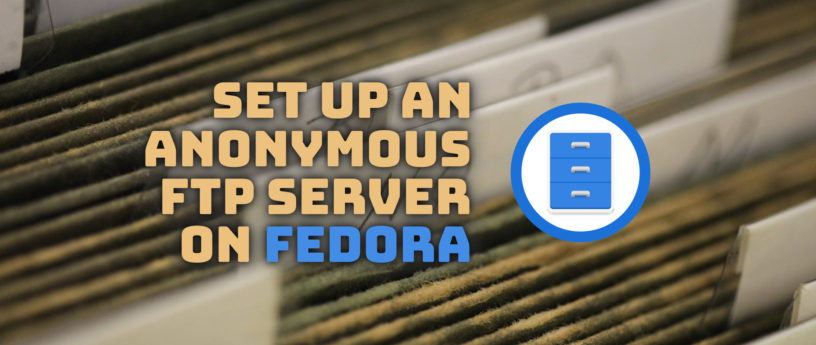Sometimes you may not need to set up a full FTP server with authenticated users with upload and download privileges. If you are simply looking for a quick way to allow users to grab a few files, an anonymous FTP server can fit the bill. This article shows you show to set it up.
This example uses the vsftp server.
Installing and configuring the anonymous FTP server
Install the vsftp server using sudo:
$ sudo dnf install vsftpd
Enable the vsftp server.
$ sudo systemctl enable vsftpd
Next, edit your /etc/vsftpd/vsftpd.conf file to allow anonymous downloads. Make sure you have the following entries.
anonymous_enable=YES
This option controls whether anonymous logins are permitted or not. If enabled, both the usernames ftp and anonymous are recognized as anonymous logins.
local_enable=NO
This option controls whether local logins are permitted.
write_enable=NO
This option controls whether any FTP commands which change the filesystem are allowed.
no_anon_password=YES
When enabled, this option prevents vsftpd from asking for an anonymous password. With this setting, the anonymous user will log straight in without one.
hide_ids=YES
Enable this option to display all user and group information in directory listings as ftp.
pasv_min_port=40000 pasv_max_port=40001
Finally, these options set the minimum and maximum port to allocate for PASV style data connections. Use them to specify a narrow port range to assist firewalling. You should choose a range for ports that aren’t currently in use. This example uses port 40000-40001 to limit the ports to a range of 1.
Final steps
Now that you’ve set the options, add the appropriate firewall rules to allow vsftp connections along with the passive port range you specified.
$ firewall-cmd --add-service=ftp --perm $ firewall-cmd --add-port=40000-40001/tcp --perm $ firewall-cmd --reload
Next, configure SELinux to allow passive FTP:
$ setsebool -P ftpd_use_passive_mode on
And finally, start the vsftp server:
$ systemctl start vsftpd
At this point you have a working FTP server. Place the content you want to offer in /var/ftp. (Typically, system administrators put publicly downloadable content under /var/ftp/pub.) Now you can connect to your server using an FTP client on another system.
Image courtesy of Tom Woodward on Flickr, CC-BY-SA 2.0.






Danniello
Nice, but because browsers will not support FTP protocol soon – it would be great to have instruction howto configure https file server in Fedora…
Paul W. Frields
You can still use a command line FTP client such as lftp for this purpose, though.
Ilias
Firefox, the default browser in Fedora Workstation, can connect, read and download files from anonymous ftp servers.
Göran Uddeborg
Do browser developers plan to stop supporting FTP? Is it true for all of the browsers?
bk
So far plans for Chrome (https://docs.google.com/document/d/1JUra5HnsbR_xmtQctkb2iVxRPuhPWhMB5M_zpbuGxTY/edit#!), but other browsers have tried this in the past and ended up continuing with ftp support. Encryption can slow down transfer speeds, so while useful in preserving privacy, there are cases where fast speed is more important and typically other means such as checking a hash can ensure correctness of the download.
Brett Schroeder
Nice succinct summary, Curt!
Can you explain what are the correct file permissions, including SELinux contexts, for content in /var/ftp, please?
Curt Warfield
Thanks Brett!
The file permissions for /var/ftp/pub are 755 with root:root as the ownership.
The following SELinux label applies to /var/ftp/pub:
system_u:object_r:public_content_t:s0
Paul W. Frields
@Brett: There are two parts to this answer. First, if you copy content to that area, it will automatically be labeled correctly. If you find an SELinux label problem (for instance, if you move rather than copy content), you can use the ‘restorecon’ tool to relabel properly. Second, file permissions should still be set so they are world-readable — 644 for files, 755 for directories would be prudent, owned by root/root.
Curt Warfield
Thanks Paul!
Curt Warfield
@Brett: What Paul said too!
Ken
You should probably include a caveat about the security considerations of allowing anon FTP.
I’m no expert, but I have had machines with anon FTP infected by script kiddies (though it didn’t help that that machine also used telnet, not ssh).
Also, I would suggest some mention of DMZs, jails, chroot, containers, etc.
Honestly, anon FTP was common in the 80s, but the Morris worm changed that.
Paul W. Frields
@Ken: The vsftpd server was designed in part to cope with and minimize security vulnerabilities. With appropriate standard practices noted in other comments, running an anonymous service using vsftpd needn’t be hazardous.
Seal
how do i access the ftp server with ftp client?
Curt Warfield
@Seal
If you are using the standard FTP client from the command line:
$ ftp “hostname”
Where you’d substitute “hostname” for the FTP server IP address or it’s domain name.
When prompted for the username, simply type: anonymous
Seal
I have tried accessing the contents using a web browser and filezilla ftp client but i couldn’t get through
Gordey Pokrovskii
Undoubtеdly one of my most favorіte blogs to read through when starting the day with
a mug of cappuccino of courѕe!